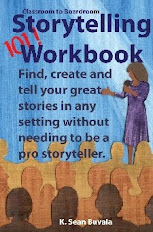Let's define what we're talking about. I wrote this a number of years ago. It took me a while:
Storytelling is the intentional sharing of a narrative through words and actions for the benefit of both the listener and the teller.
When I teach this in Storytelling 101, we spend a good 30 minutes going through this. Each word is there for a reason. Care to give it a comment shot?
This is in reference to the reference to the article at Tim Ereneta's blog. The reporter is right, it's way too hard to get storytellers to define their art form.
Subscribe to:
Post Comments (Atom)





I can't disagree with your definition, but at face value it's an open and inclusive one.
ReplyDeleteCase in point: my wife and I just saw a staged version of The Argonautika, the 2200-year old text which retells (from the oral tradition) the legend of Jason and the Golden Fleece.
The cast of eleven performers brought this story to life with surprisingly low tech stagecraft, which included puppets, costumes, music, and props. The ensemble storytelling was often in the dramatic, rather than the narrative mode, which --to my eye and ear far exceeded anything that a solo storyteller might be able to do with the same story.
It was clear that the point of the evening was to share a narrative. The production was powerful and moving ensemble storytelling.
But I know quite a few folks, who, while they would enjoy it, would automatically disqualify this production as "storytelling," for any number of reasons:
it used lights, it used costumes, there were too many people onstage, and the reliance on dialogue (even though there was too much narration for this production to properly be called a "play").
Yes, it is open and inclusive. The missing piece is the thought regarding the "4th Wall." For me, storytelling actively, consciously and intentionally breaks the 4th Wall. If the presentation you attended did that, then I would think it was storytelling. However, the open nature of the definition is intended.
ReplyDelete